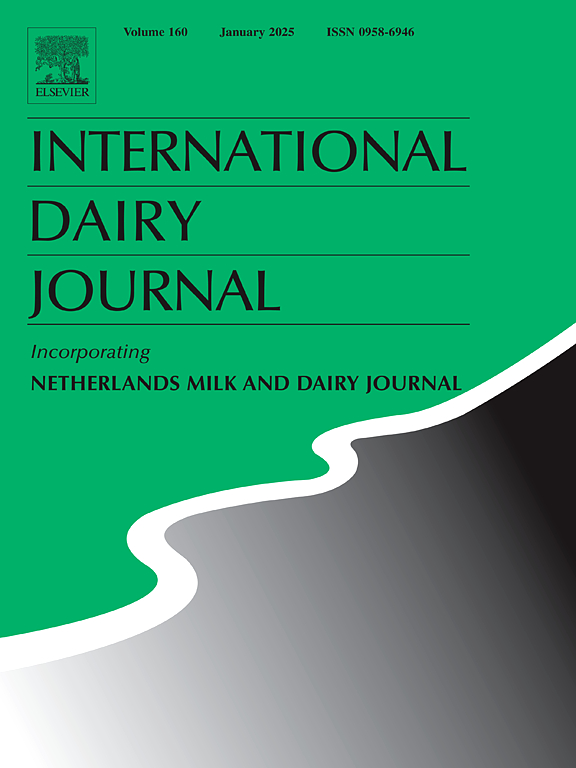脂肪酸-乳清蛋白相互作用:多光谱和计算研究
IF 3.4
3区 农林科学
Q2 FOOD SCIENCE & TECHNOLOGY
引用次数: 0
摘要
反式脂肪酸(tfa)在生理过程中起着重要作用。Elaidic acid (EA)是一种常见的TFA,在植物油的氢化过程中产生。本研究采用一系列光谱和计算方法来阐明EA与关键乳清蛋白β-乳球蛋白(β-Lgb)之间的分子相互作用。紫外可见光谱显示β-Lgb-(EA)复合物的形成,光谱变化明显。荧光光谱显示,随着EA浓度的增加,β-Lgb的发射逐渐猝灭,分析证实了静态猝灭机制。热力学参数强调范德华力和氢键是复杂稳定性的主要驱动因素,这一发现得到了分子对接数据的证实。傅里叶变换红外光谱(FTIR)表明,在圆二色性(CD)光谱反映的EA结合结果后,β-sheet和β-turn含量增加,α-螺旋含量减少。热稳定性评估,由熔融温度(Tm)测量和分子动力学(MD)模拟支持,表明在EA存在下β-Lgb稳定性增强。β-Lgb-(EA)复合物的均方根偏差(RMSD)和均方根波动(RMSF)的降低进一步验证了这一点,与FTIR结果一致,并强调了EA结合赋予的结构和热弹性。本文章由计算机程序翻译,如有差异,请以英文原文为准。
Fatty acid-whey protein interactions: A multi-spectroscopic and computational study
Trans fatty acids (TFAs) play a vital role in physiological processes. Elaidic acid (EA), a prevalent TFA, emerges during the hydrogenation of vegetable oils. This study employs an array of spectroscopic and computational methods to elucidate the molecular interactions between EA and β-lactoglobulin (β-Lgb), a key whey protein. UV–Vis spectroscopy reveals the formation of a β-Lgb-(EA) complex, evidenced by distinct spectral changes. Fluorescence spectroscopy demonstrates a progressive quenching of β-Lgb's emission as EA concentration increases, with analysis confirming a static quenching mechanism. Thermodynamic parameters highlight van der Waals forces and hydrogen bonding as the primary drivers of complex stability, a finding corroborated by molecular docking data. Fourier-transform infrared (FTIR) spectroscopy indicates an increase in β-sheet and β-turn content, alongside a reduction in α-helix, following EA binding results mirrored by circular dichroism (CD) spectroscopy. Thermal stability assessments, supported by melting temperature () measurements and molecular dynamics (MD) simulations, show enhanced β-Lgb stability in the presence of EA. This is further validated by decreased root mean square deviation (RMSD) and root mean square fluctuation (RMSF) in the β-Lgb-(EA) complex, aligning with FTIR findings and underscoring the structural and thermal resilience imparted by EA binding.
求助全文
通过发布文献求助,成功后即可免费获取论文全文。
去求助
来源期刊

International Dairy Journal
工程技术-食品科技
CiteScore
6.50
自引率
9.70%
发文量
200
审稿时长
49 days
期刊介绍:
The International Dairy Journal publishes significant advancements in dairy science and technology in the form of research articles and critical reviews that are of relevance to the broader international dairy community. Within this scope, research on the science and technology of milk and dairy products and the nutritional and health aspects of dairy foods are included; the journal pays particular attention to applied research and its interface with the dairy industry.
The journal''s coverage includes the following, where directly applicable to dairy science and technology:
• Chemistry and physico-chemical properties of milk constituents
• Microbiology, food safety, enzymology, biotechnology
• Processing and engineering
• Emulsion science, food structure, and texture
• Raw material quality and effect on relevant products
• Flavour and off-flavour development
• Technological functionality and applications of dairy ingredients
• Sensory and consumer sciences
• Nutrition and substantiation of human health implications of milk components or dairy products
International Dairy Journal does not publish papers related to milk production, animal health and other aspects of on-farm milk production unless there is a clear relationship to dairy technology, human health or final product quality.
 求助内容:
求助内容: 应助结果提醒方式:
应助结果提醒方式:


